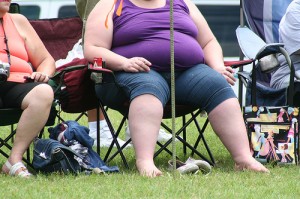For White Girls, a Bigger Penalty for Being Obese
 Photo: Tobyotter
Photo: TobyotterWe hear increasingly about the healthcare costs of obesity; but what about social costs?
A forthcoming Economics and Human Biology paper (abstract here; PDF here) by Mir Ali, Aliaksandr Amialchuk, and John Rizzo, titled “The Influence of Body Weight on Social Network Ties Among Adolescents,” makes this interesting argument:
We find that obese adolescents have fewer friends and are less socially integrated than their non-obese counterparts. We also find that such penalties in friendship networks are present among whites but not African-Americans or Hispanics, with the largest effect among white females.
As Ali added in an e-mail:
What we find is that it’s mostly White adolescents who are marginalized for being heavier and the effect is the strongest among overweight White females — i.e. few people are likely to be friends with these overweight White females and if they do have friends, those friends are also more likely to be on the fringe of the social network. There’s no social marginalization penalty for overweight African Americans or Hispanics. We hypothesize that this is mainly due to racial differences in ideal body weight norms – a thinner body ideal for Whites compared to African-Americans or Hispanics.
In related (and more far-reaching) obesity research, another paper in Economics and Human Biology paper (abstract here; PDF here) challenges the conventional wisdom on the relationship between poverty and obesity. From “Overweight and Poor?” by Dean Jolliffe of the World Bank:
Contrary to conventional wisdom, NHANES data indicate that the poor have never had a statistically significant higher prevalence of overweight status at any time in the last 35 years. Despite this empirical evidence, the view that the poor are less healthy in terms of excess accumulation of fat persists. This paper provides evidence that conventional wisdom is reflecting important differences in the relationship between income and the body mass index. The first finding is based on distribution-sensitive measures of overweight which indicates that the severity of overweight has been higher for the poor than the nonpoor throughout the last 35 years. The second finding is from a newly introduced estimator, unconditional quantile regression (UQR), which provides a measure of the income-gradient in BMI at different points on the unconditional BMI distribution. The UQR estimator indicates that the strongest relationship between income and BMI is observed at the tails of the distribution. There is a statistically significant negative income gradient in BMI at the obesity threshold and some evidence of a positive gradient at the underweight threshold. Both of these UQR estimates imply that for those at the tails of the BMI distribution, increases in income are correlated with healthier BMI values.
And, since good things come in three, here’s one more interesting recent obesity paper, from Charles Courtemanche, Garth Heutel, and Patrick McAlvanah, called “Impatience, Incentives, and Obesity” (abstract here; PDF here):
This paper explores the relationship between time preferences, economic incentives, and body mass index (BMI). Using data from the 2006 National Longitudinal Survey of Youth, we first show that greater impatience increases BMI and the likelihood of obesity even after controlling for demographic, human capital, occupational, and financial characteristics as well as risk preference. Next, we provide evidence of an interaction effect between time preference and food prices, with cheaper food leading to the largest weight gains among those exhibiting the most impatience. The interaction of changing economic incentives with heterogeneous discounting may help explain why increases in BMI have been concentrated amongst the right tail of the distribution, where the health consequences are especially severe. Lastly, we model time-inconsistent preferences by computing individuals’ quasi-hyperbolic discounting parameters (beta and delta). Both long-run patience (delta) and present-bias (beta) predict BMI, suggesting obesity is partly attributable to rational intertemporal tradeoffs but also partly to time inconsistency.
So, to summarize today’s news in obesity: white girls are disproportionately punished for obesity; a poor person is not necessarily more likely to be obese than a non-poor person (although the severity may be greater); and you are less likely to be obese if you are more patient.
Calories burned while reading this too-long blog post: roughly 150.
Carry on.

Comments